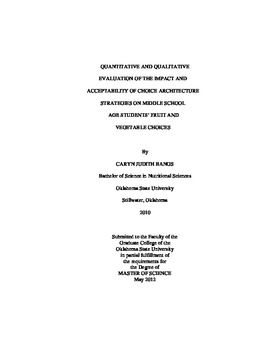| dc.contributor.advisor | Hildebrand, Deana A. | |
| dc.contributor.author | Bangs, Caryn Judith | |
| dc.date.accessioned | 2014-04-15T22:00:55Z | |
| dc.date.available | 2014-04-15T22:00:55Z | |
| dc.date.issued | 2012-05-01 | |
| dc.identifier.uri | https://hdl.handle.net/11244/9207 | |
| dc.description.abstract | Childhood obesity is a nationwide problem with serious future implications and is partly due to inadequate consumption of fruit and vegetables (FV). Choice architecture (CA) strategies, a principle of behavioral economics, have been shown to be an effective method to influence FV selection in the school environments. Objectives of the study were to 1) assess the impact of CA strategies, 2) conduct a plate waste study to evaluate consumption of self-served FV, and 3) assess the attitudes of school nutrition personnel regarding the use of CA strategies. Methods included implementation of a CA strategy in 3 middle school settings. Baseline and intervention data were collected using existing food production records. The plate waste study was conducted at 1 school using pre and post meal photos of students' trays. Six focus groups were conducted with 36 school nutrition professionals from various districts in Oklahoma to assess the clarity of the strategies, attitudes toward and feasibility of using the strategies. Analysis of 2 CA strategy interventions at school 1 found increases of 1 cup servings of FV by 29% and 24% over baseline. Site 2 intervention showed a 15% increase 1 cup servings of FV with a significant increase in fresh fruit (P=0.015) over baseline. Site 3 increased 1 cup servings of FV by 9% and showed a significant decrease in fried white potatoes (P=0.041) compared to baseline. The 2 day plate waste study found on average, students consumed 92% of FV selected. Focus groups revealed that while certain strategies are more feasible than others, some strategies are already used and school nutrition professionals believe CA strategies can and should be implemented in schools. In conclusion, CA strategies appear to be a promising method to increase student FV selection and are considered as feasible and sustainable to school nutrition professionals in Oklahoma. | |
| dc.format | application/pdf | |
| dc.language | en_US | |
| dc.publisher | Oklahoma State University | |
| dc.rights | Copyright is held by the author who has granted the Oklahoma State University Library the non-exclusive right to share this material in its institutional repository. Contact Digital Library Services at lib-dls@okstate.edu or 405-744-9161 for the permission policy on the use, reproduction or distribution of this material. | |
| dc.title | Quantitative and Qualitative Evaluation of the Impact and Acceptability of Choice Architecture Strategies on Middle School Age Students' Fruit and Vegetable Choices | |
| dc.type | text | |
| dc.contributor.committeeMember | Kelsey, Kathleen | |
| dc.contributor.committeeMember | Kennedy, Tay | |
| osu.filename | Bangs_okstate_0664M_11912.pdf | |
| osu.college | Human Environmental Sciences | |
| osu.accesstype | Open Access | |
| dc.description.department | Department of Nutritional Sciences | |
| dc.type.genre | Thesis | |
| dc.subject.keywords | behavioral economics | |
| dc.subject.keywords | choice architecture | |
| dc.subject.keywords | fruit and vegetables | |
| dc.subject.keywords | school nutrition | |
